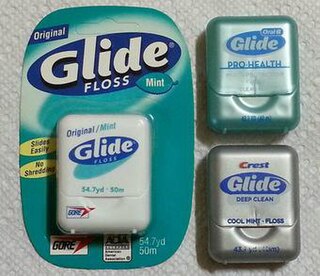
The Cape Fear River is a 191.08-mile-long blackwater river in east-central North Carolina. It flows into the Atlantic Ocean near Cape Fear, from which it takes its name. The river is formed at the confluence of the Haw River and the Deep River in the town of Moncure, North Carolina. Its river basin is the largest in the state: 9,149 sq mi.

Perfluorooctanoic acid is a perfluorinated carboxylic acid produced and used worldwide as an industrial surfactant in chemical processes and as a material feedstock. PFOA is considered a surfactant, or fluorosurfactant, due to its chemical structure, which consists of a perfluorinated, n-heptyl "tail group" and a carboxylate "head group". The head group can be described as hydrophilic while the fluorocarbon tail is both hydrophobic and lipophobic.

Perfluorooctanesulfonic acid (PFOS) is a chemical compound having an eight-carbon fluorocarbon chain and a sulfonic acid functional group and thus a perfluorosulfonic acid. It is an anthropogenic (man-made) fluorosurfactant, now regarded as a global pollutant. PFOS was the key ingredient in Scotchgard, a fabric protector made by 3M, and related stain repellents. The acronym "PFOS" refers to the parent sulfonic acid and to various salts of perfluorooctanesulfonate. These are all colorless or white, water-soluble solids. Although of low acute toxicity, PFOS has attracted much attention for its pervasiveness and environmental impact. It was added to Annex B of the Stockholm Convention on Persistent Organic Pollutants in May 2009.

Persistent organic pollutants (POPs) are organic compounds that are resistant to degradation through chemical, biological, and photolytic processes. They are toxic chemicals that adversely affect human health and the environment around the world. Because they can be transported by wind and water, most POPs generated in one country can and do affect people and wildlife far from where they are used and released.

Tomalley, crab fat, or lobster paste is the soft, green substance found in the body cavity of lobsters, that fulfills the functions of both the liver and the pancreas. Tomalley corresponds to the hepatopancreas in other arthropods. It is considered a delicacy, and may be eaten alone but is often added to sauces for flavour and as a thickening agent. The term lobster paste or lobster pâté can also be used to indicate a mixture of tomalley and lobster roe. Lobster bisque, lobster stock, and lobster consommé are made using lobster bodies (heads), often including tomalley.

Microwave popcorn is a convenience food consisting of unpopped popcorn in an enhanced, sealed paper bag intended to be heated in a microwave oven. In addition to the dried corn, the bags typically contain cooking oil with sufficient saturated fat to solidify at room temperature, one or more seasonings, and natural or artificial flavorings or both. With the many different flavors, there are many different providers.

Environmental toxicology is a multidisciplinary field of science concerned with the study of the harmful effects of various chemical, biological and physical agents on living organisms. Ecotoxicology is a subdiscipline of environmental toxicology concerned with studying the harmful effects of toxicants at the population and ecosystem levels.
Perfluorononanoic acid, or PFNA, is a synthetic perfluorinated carboxylic acid and fluorosurfactant that is also an environmental contaminant found in people and wildlife along with PFOS and PFOA.

Per- and polyfluoroalkyl substances (PFAS or PFASs) are a group of synthetic organofluorine chemical compounds that have multiple fluorine atoms attached to an alkyl chain. An early definition, from 2011, required that they contain at least one perfluoroalkyl moiety, –CnF2n+1–. Beginning in 2021, the Organisation for Economic Co-operation and Development (OECD) expanded their terminology, stating that "PFASs are defined as fluorinated substances that contain at least one fully fluorinated methyl or methylene carbon atom (without any H/Cl/Br/I atom attached to it), i.e. with a few noted exceptions, any chemical with at least a perfluorinated methyl group (–CF3) or a perfluorinated methylene group (–CF2–) is a PFAS."
Fluorotelomer alcohols, or FTOHs, are fluorotelomers with an alcohol functional group. They are volatile precursors to perfluorinated carboxylic acids, such as PFOA and PFNA, and other compounds.

Perfluorobutanesulfonic acid (PFBS) is a PFAS chemical compound having a four-carbon fluorocarbon chain and a sulfonic acid functional group. It is stable and unreactive because of the strength of carbon–fluorine bonds. It can occur in the form of a colorless liquid or a corrosive solid. Its conjugate base is perfluorobutanesulfonate which functions as the hydrophobe in fluorosurfactants.
Fluorotelomers are fluorocarbon-based oligomers, or telomers, synthesized by telomerization. Some fluorotelomers and fluorotelomer-based compounds are a source of environmentally persistent perfluorinated carboxylic acids such as PFOA and PFNA, while others are under extended investigation.

A perfluorinated compound (PFC) or perfluoro compound is an organofluorine compound lacking C-H bonds. Many perfluorinated compounds have properties that are quite different from their C-H containing analogues. Common functional groups in PFCs are OH, CO2H, chlorine, O, and SO3H. Electrofluorination is the predominant method for their production. Due to their chemical stability, some of these perfluorinated compounds bioaccumulate.

Perfluorooctanesulfonamide (PFOSA) is a synthetic organofluorine compound. It is a fluorocarbon derivative and a perfluorinated compound, having an eight-carbon chain and a terminal sulfonamide functional group. PFOSA, a persistent organic pollutant, was an ingredient in 3M's former Scotchgard formulation from 1956 until 2003, and the compound was used to repel grease and water in food packaging along with other consumer applications. It breaks down to form perfluorooctane sulfonate (PFOS). The perfluorooctanesulfonyl fluoride-based chemistry that was used to make sulfonamides like PFOSA was phased out by 3M in the United States (US) during 2000–2002 but it has grown in China by other producers.

Perfluorooctanesulfonyl fluoride (POSF) is a synthetic perfluorinated compound with a sulfonyl fluoride functional group. It is used to make perfluorooctanesulfonic acid (PFOS) and PFOS-based compounds. These compounds have a variety of industrial and consumer uses, but POSF-derived substances ultimately degrade to form PFOS.

Oral-B Glide is a PTFE (Teflon) dental floss manufactured by W. L. Gore and Associates exclusively for Procter & Gamble.

Fluorine may interact with biological systems in the form of fluorine-containing compounds. Though elemental fluorine (F2) is very rare in everyday life, fluorine-containing compounds such as fluorite occur naturally as minerals. Naturally occurring organofluorine compounds are extremely rare. Man-made fluoride compounds are common and are used in medicines, pesticides, and materials. Twenty percent of all commercialized pharmaceuticals contain fluorine, including Lipitor and Prozac. In many contexts, fluorine-containing compounds are harmless or even beneficial to living organisms; in others, they are toxic.

Water contamination in Lawrence and Morgan Counties, Alabama, revolves around the presence of perfluorooctanoic acid (PFOA) and perfluorooctanesulfonic acid (PFOS) in the water supply. After the US Environmental Protection Agency (EPA) released new health advisories in March 2016, there was concern over health risks of the levels of PFOA and PFOS present. The responses of different government officials, agencies, and companies raise questions as to whether or not there was any environmental injustice involved.
GenX is a Chemours trademark name for a synthetic, short-chain organofluorine chemical compound, the ammonium salt of hexafluoropropylene oxide dimer acid (HFPO-DA). It can also be used more informally to refer to the group of related fluorochemicals that are used to produce GenX. DuPont began the commercial development of GenX in 2009 as a replacement for perfluorooctanoic acid.
This timeline of events related to per- and polyfluoroalkyl substances (PFASs) includes events related to the discovery, development, manufacture, marketing, uses, concerns, litigation, regulation, and legislation, involving the human-made PFASs. The timeline focuses on some perfluorinated compounds, particularly perfluorooctanoic acid (PFOA) and perfluorooctanesulfonic acid (PFOS) and on the companies that manufactured and marketed them, mainly DuPont and 3M. An example of PFAS is the fluorinated polymer polytetrafluoroethylene (PTFE), which has been produced and marketed by DuPont under its trademark Teflon. GenX chemicals and perfluorobutanesulfonic acid (PFBS) are organofluorine chemicals used as a replacement for PFOA and PFOS.



 [1]
[1] 













